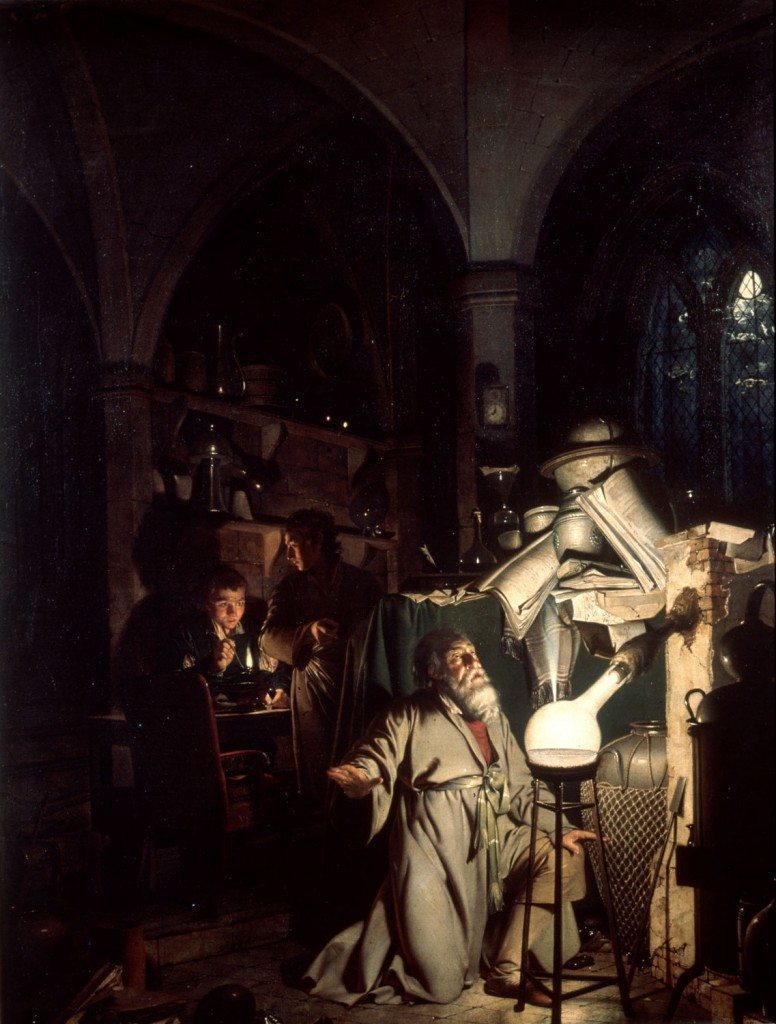Introduction: Between Enlightenment and Romanticism
Alchymist in Search of the Philosopher’s Stone, (exhibited 1775, reworked 1795). Joseph Wright of Derby (1734-1797), Oil on canvas. Derby Museum & Art Gallery.
Image: This is one of Wright’s overtly allegorical paintings. He shows an alchymist seeking the “Philosopher’s Stone”, the substance which turns base metal into gold and cure all the world’s ills. The word alchymy or alchemy is derived from the Arabic for chemistry; the use of the word as synonymous with unscientific magic is recent, but was also current in the 18th century. Wright portrays a laboratory rather than a magician’s cave and the alchymist instead of finding the “Philosopher’s Stone” has discovered phosphorus, popularly known as the “Devil’s Element”, which bursts into light and illuminates the faces of the experimenter and his assistants. The awe-struck alchymist is present at a birth, not of the Christ-child but of the power of discovery to illuminate, change and terrify the world, an experience which Darwin and Priestley shared.
1. Introduction: Between Enlightenment and Romanticism
The West Midlands cultural milieu provided sufficient elements to define a particular kind of Enlightenment, whose specific value dramatically outstripped the borders of conventional historical partitions. Scholars have stressed, for instance, the deep commitment of the thought and the “style” of some west Midlands players to the construction of British Romanticism.1 Internationally known philosophers, scientists, and strong supporters of the Industrial Revolution, Erasmus Darwin (1731-1802) and Joseph Priestley (1733-1804), better than other “Lunar men”, have been the interpreters of this west Midlands, “pre-Romantic” Enlightenment.2
Like the well-known French philosophes, of course, these men were rationalists fond of progress and useful science. Darwin and Priestley took part in the European Enlightenment and hence they appear naturally doubtful of Calvinistic predestination, aristocratic privilege and ancestral lineage. They tried to promote sociability, education, arts, individual pleasures and cheerfulness, to foster, in short, the “happiness” of humankind.
Nevertheless, Darwin’s and Priestley’s mineralogical, geological, chemical, botanical and medical enquiries were not wholly developed to buttress objective science, impersonal technology and money-making industry. They were not simply forerunners or advocates of a pre-twentieth-century secularism. Their enquiries, whose results are scattered in poems, botanical, chemical, and physiological treatises, moral essays, philosophical letters and sermons, hung on a pre-Enlightenment idea of knowledge. For Darwin and Priestley, natural philosophy was not yet specialized. “The Alchymist in Search of the Philosopher’s Stone” was not only the title of an exciting and emotional painting by Joseph Wright. It is, so to say, a heading stamped at the very entrance of an “ethical laboratory” where res (things) are not clearly detached from verba (words), where things have a value of their own, where Darwin, Priestley and other scientist-philosophers, like sorcerers involved in a mystic enterprise, could undergo a metamorphosis or a dissection of their own body, in order to break up accepted customs and let nature and matter carry out all their terrific power. Darwin’s and Priestley’s cultural challenge place humans into the material, earthly world, and shed light on human existence to clarify the possibilities this world could realistically provide. Upon the “Frankensteinian” Enlightenment of these two father-figures, upon a cultural world where “alchemy should be respected as a genuine search for wisdom”, and James Watt’s steam was “demonic in its strength, a hissing, heaving animal of fire and water and air”, this paper is concentrated.3
Continue browsing this section
 Both Sides of the Moon: Erasmus Darwin, Joseph Priestley and the West Midlands’ Enlightenment
Both Sides of the Moon: Erasmus Darwin, Joseph Priestley and the West Midlands’ Enlightenment
 Introduction: Between Enlightenment and Romanticism
Introduction: Between Enlightenment and Romanticism
 The Philosophical Context: From Optimism to Realism
The Philosophical Context: From Optimism to Realism
 Priestley: Body, Matter and Death
Priestley: Body, Matter and Death
 Darwin, Priestley and Romantic Materialism
Darwin, Priestley and Romantic Materialism
 Conclusion: Classical Order versus Romantic Nature
Conclusion: Classical Order versus Romantic Nature
 Footnotes
Footnotes






